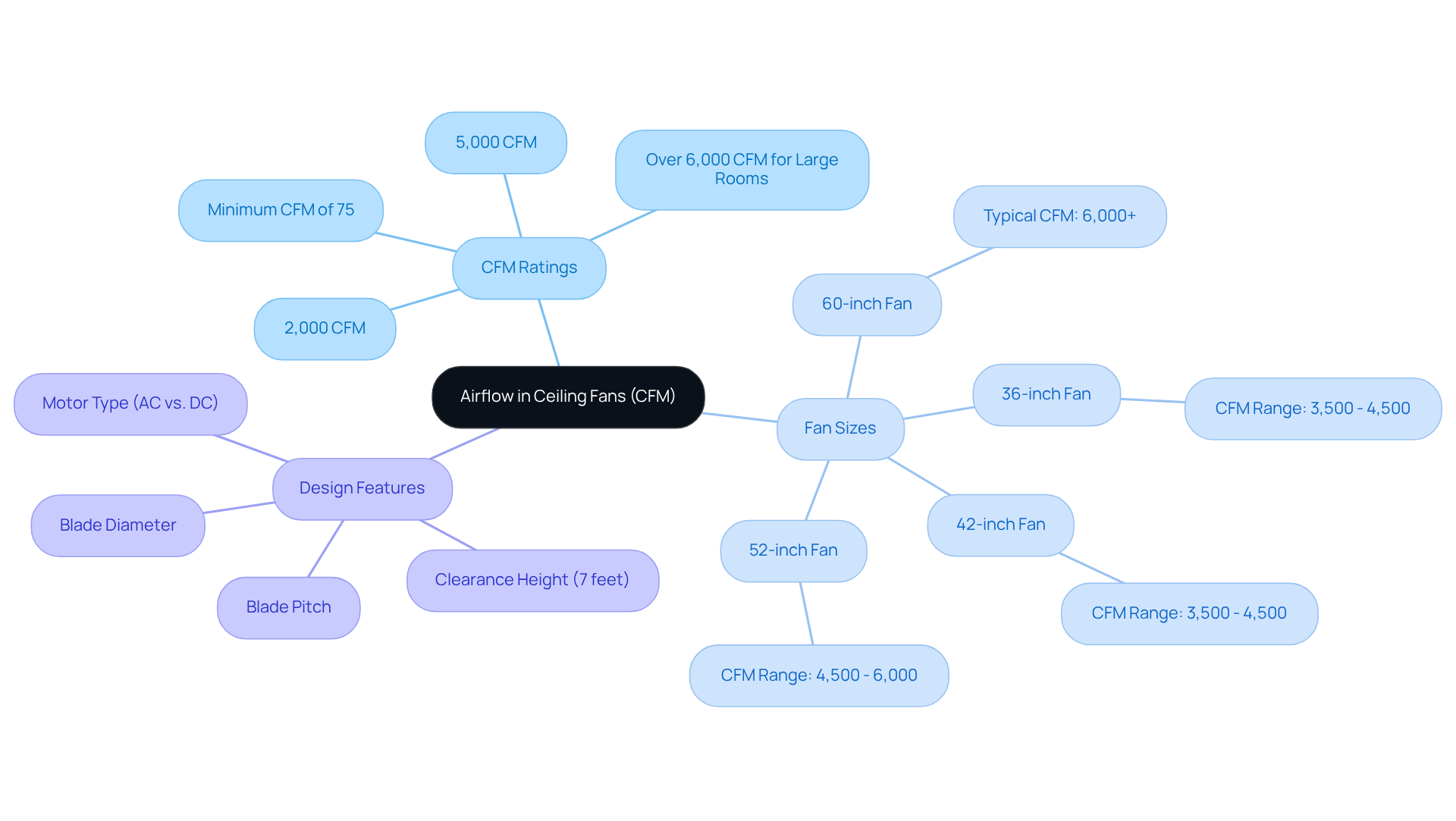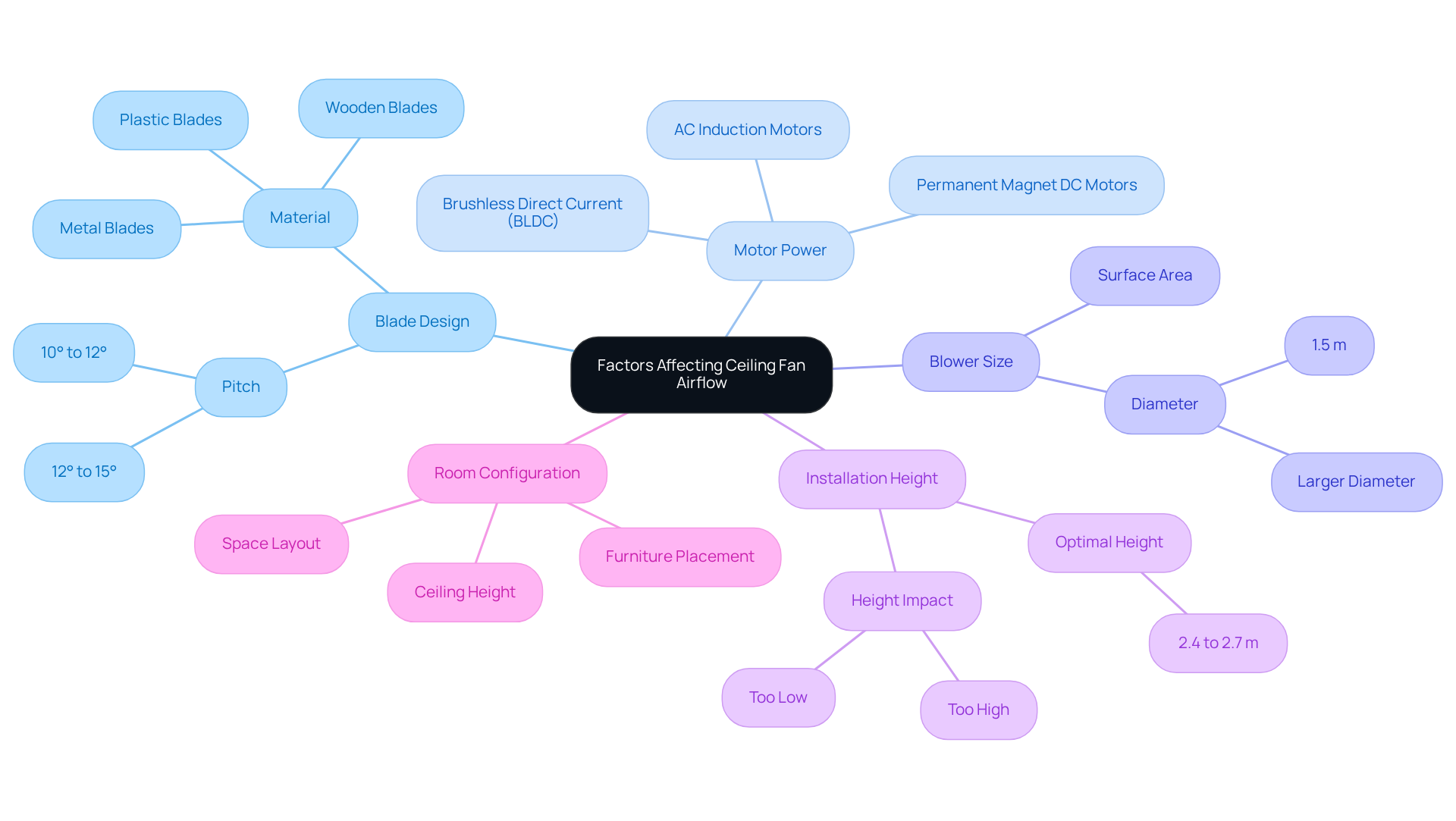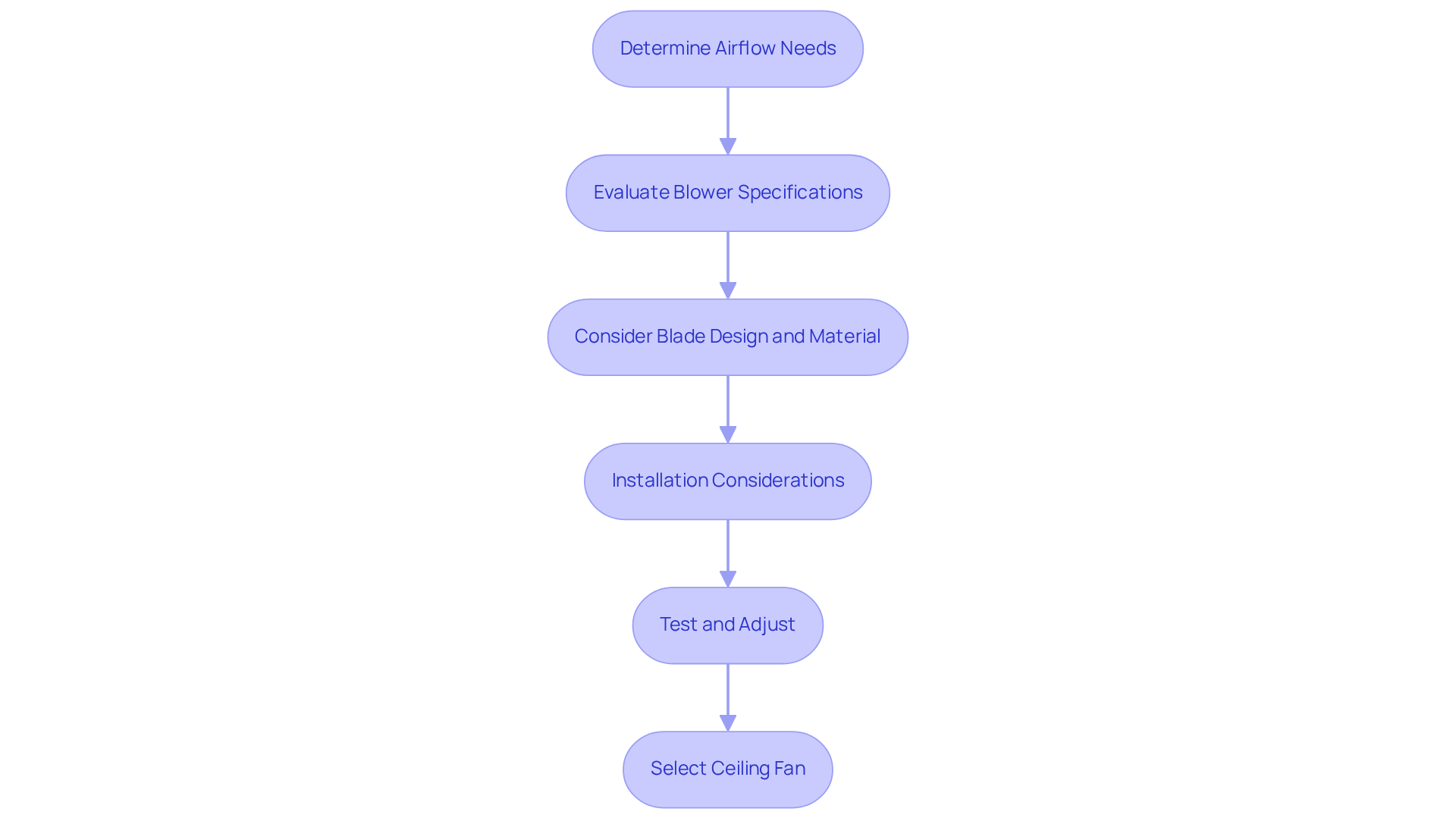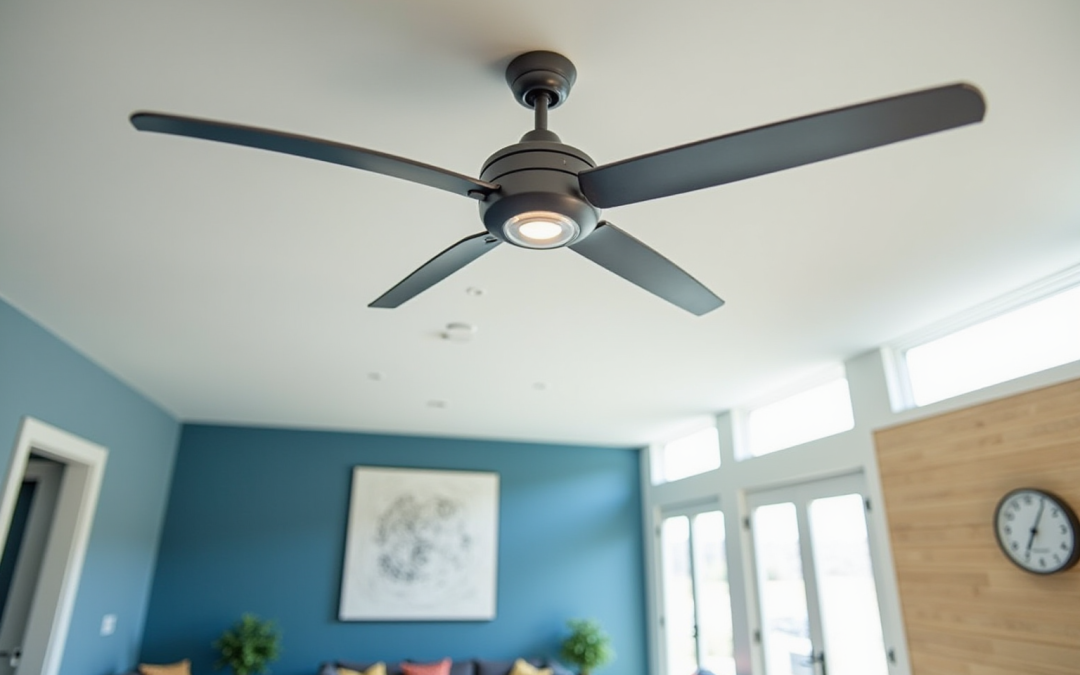Overview
This article addresses the critical challenge engineers face in maximizing airflow through the strategic selection of ceiling fans that optimize air movement, quantified in Cubic Feet per Minute (CFM). The significance of CFM ratings cannot be overstated; they serve as a benchmark for evaluating fan performance.
Furthermore, factors such as:
- Blade design
- Motor power
- Appropriate installation height
play pivotal roles in enhancing air circulation and energy efficiency across diverse environments. By understanding and integrating these elements, engineers can significantly improve the effectiveness of airflow solutions.
Introduction
Understanding the intricacies of airflow is crucial for enhancing comfort and energy efficiency in any space. Ceiling fans, quantified by their Cubic Feet per Minute (CFM) ratings, are pivotal in this equation; higher CFM values indicate superior air movement capabilities.
However, selecting the right fan entails more than merely checking the CFM. It requires a careful consideration of:
- Design features
- Motor power
- Installation factors
Engineers face numerous challenges when navigating these options. How can they ensure the selection of fans that not only meet airflow needs but also promote energy efficiency?
Clarify Airflow and CFM in Ceiling Fans
Airflow in ceiling units is quantified in Cubic Feet per Minute (CFM), a critical metric that measures the volume of air an appliance can move in one minute. A higher CFM rating signifies fans that move the most air, which are essential for effectively circulating air and maintaining comfortable temperatures, particularly in larger spaces. For instance, a fan with a CFM rating of 5,000 can cool a room significantly better than one rated at 2,000 CFM. Current industry standards indicate that for optimal cooling, units should incorporate fans that move the most air, with a minimum CFM of 75, and larger models exceeding 6,000 CFM for expansive areas. A 60-inch fan is one of the fans that move the most air, typically achieving a CFM of over 6,000, making it ideal for open spaces.
When assessing ceiling units, it is crucial to consider not just the CFM but also the , such as blade pitch and diameter, which significantly affect the efficiency of air movement. For example, fans with 36-inch blades are suited for rooms up to 75 square feet, generally offering a CFM range of 3,500 to 4,500. Additionally, ensuring at least 7 feet of clearance from the floor to the fan blades is vital for optimal performance and safety.
Understanding these metrics empowers engineers to select the appropriate fan for specific applications, ensuring both optimal performance and energy efficiency. By focusing on CFM ratings and design features, engineers can enhance air circulation, reduce energy costs, and improve overall comfort in various environments.

Examine Factors Affecting Ceiling Fan Airflow
Several factors significantly influence the airflow produced by ceiling fans:
- Blade Design: The shape, pitch, and material of the blades are critical for the efficiency of movement. Blades with a higher pitch, such as those with a pitch of 12° to 15°, are considered fans that move the most air, while aerodynamic designs minimize turbulence, enhancing overall performance. Studies indicate that blades with a pitch of 12° to 15° offer balanced circulation, making them appropriate for standard rooms.
- Motor Power: A more robust motor can propel the blades at greater speeds, thus enhancing air circulation. However, it is crucial to balance motor power with energy efficiency to prevent excessive energy consumption. For instance, fans that move the most air and are equipped with Brushless Direct Current (BLDC) motors consume less electricity while still maintaining high airflow, making them a cost-effective choice.
- Blower size: Larger blowers are fans that move the most air due to their expanded blade surface area. Selecting the appropriate fan size for the room is essential for effective cooling. Research shows that larger diameter blowers, such as those with a diameter of 1.5 m, provide a more uniform air speed distribution, which is vital for maintaining comfort in larger spaces.
- Installation Height: The height at which a fan is installed can significantly affect its performance. Fans positioned too high may not circulate air effectively, while those installed too low can create uncomfortable drafts. The optimal installation height is typically around 2.4 to 2.7 meters (8 to 9 feet) for residential applications.
- Room Configuration: The layout of the room, including furniture placement and ceiling height, influences air circulation. Understanding these dynamics enables engineers to for maximum effectiveness. For example, devices placed in spaces with elevated ceilings might require larger diameters to guarantee sufficient circulation reaches the occupied area.
By considering these elements, engineers can enhance the performance of ceiling devices, ensuring they provide optimal air circulation and energy efficiency in various settings.

Select Ceiling Fans for Optimal Air Movement
When selecting ceiling fans for optimal air movement, engineers must follow these essential steps:
- Determine Airflow Needs: Begin by assessing the size of the space and the desired airflow, measured in Cubic Feet per Minute (CFM), based on the room’s purpose. For instance, larger spaces such as warehouses typically require devices with higher CFM ratings to ensure adequate air circulation. A room measuring 15 ft x 12 ft x 10 ft has a volume of 1,800 cubic feet, necessitating approximately 300 CFM for 10 air changes per hour (ACH).
- Evaluate Blower Specifications: Seek blowers that boast high CFM ratings and efficient motor designs. It is crucial to look for , such as ENERGY STAR, which indicate lower operational costs and improved energy performance. In 2025, ceiling devices with ENERGY STAR ratings are projected to save consumers up to $30,000 annually in energy expenses, making them a prudent choice for engineers. Anguil Environmental notes, “The improved efficiency results in operating cost savings of approximately $230 per startup and up to $30,000 annually.”
- Consider blade design and material: Opt for fans that move the most air, which have blades engineered for optimal air movement. Materials such as high-grade plastics or wood not only enhance durability but also improve performance, ensuring that the fan operates effectively over time.
- Installation Considerations: Proper installation is paramount for maximizing ventilation. Ensure the fan is mounted at the correct height and location, utilizing adjustable mounting kits if necessary to optimize air distribution throughout the space.
- Test and Adjust: After installation, evaluate the fan’s performance and make necessary adjustments. This may involve modifying fan speed settings or relocating the fan to enhance air circulation, ensuring that the system operates at optimal efficiency.
By adhering to these guidelines, engineers can select ceiling fans that not only meet their airflow requirements but also promote energy efficiency and enhance overall system performance.

Conclusion
Understanding airflow and the critical role of Cubic Feet per Minute (CFM) is essential for engineers aiming to maximize ceiling fan efficiency. Recognizing that a fan’s CFM rating directly correlates with its air circulation capability underscores the importance of selecting the right fan, which can significantly enhance comfort levels and energy efficiency across various environments.
This article thoroughly examines the factors influencing ceiling fan performance, including:
- Blade design
- Motor power
- Blower size
- Installation height
- Room configuration
Each element plays a vital role in determining a fan’s effectiveness in moving air, emphasizing the necessity of a comprehensive assessment prior to selection. Furthermore, the guidelines for choosing ceiling fans highlight the need to evaluate:
- Airflow requirements
- Blower specifications
- Installation considerations
to ensure optimal performance.
Ultimately, engineers are encouraged to prioritize these insights when selecting ceiling fans to achieve the best airflow possible. By concentrating on CFM ratings and understanding the nuances of fan design and installation, substantial energy savings and enhanced air circulation can be realized. Embracing these principles not only leads to improved comfort but also contributes to a more sustainable approach in engineering practices.
Frequently Asked Questions
What does CFM stand for in relation to ceiling fans?
CFM stands for Cubic Feet per Minute, which measures the volume of air a ceiling fan can move in one minute.
Why is a higher CFM rating important for ceiling fans?
A higher CFM rating indicates that a fan can move more air, which is essential for effectively circulating air and maintaining comfortable temperatures, especially in larger spaces.
What is the minimum CFM rating recommended for optimal cooling?
The current industry standards recommend a minimum CFM of 75 for optimal cooling.
How does the size of a ceiling fan affect its CFM rating?
Larger ceiling fans, such as those with a diameter of 60 inches, typically achieve a CFM rating of over 6,000, making them ideal for cooling open spaces.
What factors should be considered alongside CFM when assessing ceiling fans?
In addition to CFM, design features such as blade pitch and diameter significantly affect the efficiency of air movement.
What is the recommended CFM range for fans with 36-inch blades?
Fans with 36-inch blades are suited for rooms up to 75 square feet and generally offer a CFM range of 3,500 to 4,500.
What is the recommended clearance from the floor for optimal fan performance?
It is vital to ensure at least 7 feet of clearance from the floor to the fan blades for optimal performance and safety.
How can understanding CFM ratings and design features benefit engineers?
Understanding these metrics enables engineers to select the appropriate fan for specific applications, ensuring optimal performance, energy efficiency, enhanced air circulation, and improved overall comfort.

